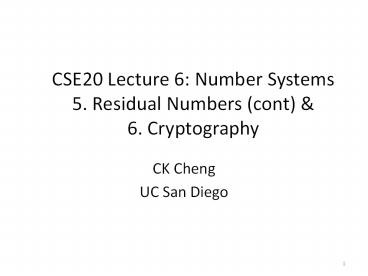CSE20 Lecture 6: Number Systems 5. Residual Numbers (cont) - PowerPoint PPT Presentation
1 / 15
Title:
CSE20 Lecture 6: Number Systems 5. Residual Numbers (cont)
Description:
CSE20 Lecture 6: Number Systems 5. Residual Numbers (cont) & 6. Cryptography CK Cheng UC San Diego * Residual Numbers (NT-1 and Shaum s Chapter 11) Introduction ... – PowerPoint PPT presentation
Number of Views:63
Avg rating:3.0/5.0
Title: CSE20 Lecture 6: Number Systems 5. Residual Numbers (cont)
1
CSE20 Lecture 6 Number Systems5. Residual
Numbers (cont) 6. Cryptography
- CK Cheng
- UC San Diego
2
Residual Numbers(NT-1 and Shaums Chapter 11)
- Introduction
- Definition
- Operations
- Inverse Conversion
3
Inverse Conversion
Number x
Mod Operation
Residual number (x1, x2, , xk) , -, x
operations for each xi under mi
Moduli (m1, m2, , mk)
Results
Chinese Remainder Theorem
4
Chinese Remainder Theorem
- Given a residual number (r1, r2, , rk) with
moduli (m1, m2, , mk), where all mi are mutually
prime, set M m1m2 mk, and MiM/mi. - 1. Find Si that (MiSi)mi 1 (Si an inverse of
Mi in mod mi) - 2. The corresponding number
- x (?i1,k(Mi Si ri))M.
5
Example
- Given (m1,m2,m3)(2,3,7), M23742, we have
- M1m2m33721 (M1S1)m1(21S1)21
- M2m1m32714 (M2S2)m2(14S2)31
- M3m1m2236 (M3S3)m3(6S3)71
- Thus, (S1, S2, S3) (1,2,6)
- For a residual number (0,2,1)
- x(M1S1r1 M2S2r2 M3S3r3)M
- (2110 1422 661 )42
- ( 0 56 36 )42 9242 8
6
Example
- For a residual number (1,2,5)
- x(M1S1r1 M2S2r2 M3S3r3)M
- (2111 1422 665)42
- (21 56 180)42
- 25742 5
7
Example iClicker
- Given (m1,m2,m3)(2,3,5), M23530, we have
- M1m2m33515 (M1S1)m1(15S1)21
- M2m1m32510 (M2S2)m2(10S2)31
- M3m1m2236 (M3S3)m3(6S3)51
- Thus, (S1, S2, S3) is
- A. (1, 1, 1)
- B. (1, 2, 1)
- C. (2, 1, 2)
- D. None of the above
8
Example iClicker
- Given (m1,m2,m3)(2,3,5), M23530, we have
- M1m2m33515 (M1S1)m1(15S1)21
- M2m1m32510 (M2S2)m2(10S2)31
- M3m1m2236 (M3S3)m3(6S3)51
- For a residual number (x1,x2,x3)(1,2,3), the
corresponding number x is - A. 5
- B. 19
- C. 23
- D. None of the above
9
Proof of Chinese Remainder Theorem
- Let A ?i1,k(Mi Si ri), we show that
- 1. Amv rv and 2. xAM is unique.
- 1. Amv ?i1,k(Mi Si ri) mv
- S(MiSiri) mvmv (MvSvrv)mv
- (MvSv)mv rvmv mv rvmv rv
- 2. Proof was shown in lecture 5.
10
6. Cryptography
- Introduction
- RSA Protocol
- Remarks
11
6.1 Cryptography Introduction
- Application of residual number systems
- Number theory (skip)
- Show the basic concept and process
- Many variations
12
6.2 RSA Protocol
Private M
- Function P(X)XeN is public.
- Function S(X)XdN is secret.
- Message M is private, but P(M) is observed by
all. - Desired feature S(P(M))M.
- Example (e,N)(7,55), (d,N)(23,55)
- M12 gt P(12)1275523 gt S(23)23235512
- M8 gt P(8)87552 gt S(2)22355?
13
6.2 RSA Protocol
- Npq where p q are primes and kept secret.
- e is mutually prime to f(N)(p-1)(q-1)
- d is the inverse of e mod f(N), i.e. (ed)f(N)1
- Theorem S(P(M))P(S(M))M for 0ltMltN
- Note that S(P(M))MedN
- Theorem Mf(N)N1 for 0ltMltN
- Assumption p q are hard to find. Consequently,
it is difficult to derive d.
14
6.2 RSA Protocol
- Npq where p q are primes and kept secret.
- e is mutually prime to f(N)(p-1)(q-1)
- d is the inverse of e mod f(N), i.e. (ed)f(N)1
- Example Npq3x1133, f(N)(3-1)(11-1)20
- Let e3, then d7 (3x7201).
- M9 gt P(9)93333 gt S(3)3733?
15
6.3 Remark
- Residual number system is used in cryptography.
- RSA protocol uses public key for coding P(X) and
secret key to decode S(X). - Use wide words (gt1000 bits) so that the solution
is computationally expensive without the
knowledge of the function S(X).






























